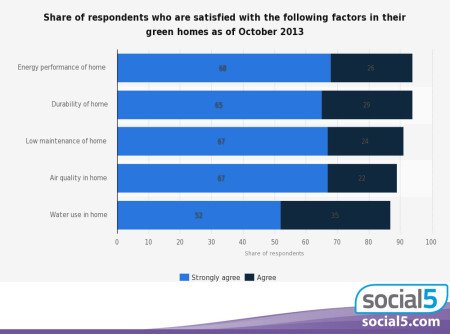Homeowners are happy building green real estate

One of the major trends shifting the types of residential real estate being built by custom home builders today in the U.S. is the trend toward going green. That means real estate is constructed to meet the National Green Building Standard. To meet this standard, a custom home builder must use sustainable, durable building materials; construct buildings that consume less energy and water; and produce fewer health-affecting emissions than standard buildings.
Although it’s true there are incentives for going green as a custom home builder, it’s reasonable to ask why a homeowner would be persuaded to focus on green real estate.
A few data points offer some clarity on the issue of buyer motivation. According to a recent study, for example, two-thirds of homeowners who own residential real estate that meets the National Green Building Standard express strong satisfaction with the improved air quality, durability, energy efficiency and water consumption of their green homes.
Lower energy consumption by real estate
The green certification requires better insulation, leak-free ductwork, sealed doors and windows, and energy-efficient lighting, appliances and heating and air-conditioning systems. These all pay for themselves over time in the form of lower annual energy bills. Homeowners can also be confident in their decision to pursue a green home because chances are good it will feature added benefits such as:
- Cooler rooms in the summertime, thanks to improved doors and windows as well as insulation that keeps the sun’s rays at bay
- Cozier rooms in the wintertime, as fewer drafts will occur thanks to better insulation
- Longer-lasting light bulbs and appliances that draw less power and require fewer energy reserves to operate
- Leadership in the community, enabling friends and neighbors to see the positive benefits of adopting energy-efficient materials and technology
Greater durability
Green-certified buildings are constructed of materials that last longer, meaning lower costs for maintenance and replacement—not to mention greater peace of mind for the homeowner. For example, some green roofing materials have 40- or 50-year warranties—more than double the lifespan of standard shingles. Even though these items cost more early on in the construction process, they end up saving the homeowner money over the lifetime of the real estate. An extensive roof repair or replacement can cost thousands upon thousands of dollars, but homeowners who work to develop green-certified real estate can take comfort knowing they’ve invested important and lasting work on the front end of the construction project.
Better indoor air quality
Green certification requires paints, caulking, adhesive, sealants and finishes that have low volatile organic compound (VOC) content and low emissions. This means those living in green homes should experience fewer odors and fewer reactions and health issues.
It also means that the heating, ventilation and air-conditioning (HVAC) systems bring fresh air into the home and filter recirculated air.
Mold prevention, non-toxic pest control and non-toxic cleansers also add up to much better indoor air quality.
Reduced water use
Green certification also requires builders to install efficient water-supply systems, low-flow faucets and shower heads, dual-flush toilets, and methods to manage rain runoff for minimal water waste and optimal use of available water.
Rainey’s commitment to green building practices
As a leading builder of custom homes in North Salt Lake Utah, Rainey Homes has always been committed to exceeding standards of energy efficiency and green building practices. Our home buyers enjoy the benefits of higher quality real estate, a healthier home environment and lower ownership costs. Longer-lasting materials, and reduced energy and water consumption save families a lot of money over the years. When added up across the country, these precious resources can be directed where we need them most.


